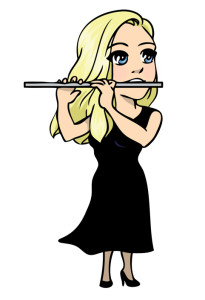
Flute Tunes
Feb 27, 2014Flute Tunes
Around the World
When people think of the flute they typically associate it with the orchestra or at least classical music in general. However, the actual uses of the flute are not this simple. There are flute tunes all around us. The flute in its many various forms is used across cultures. It consequently has a rich history of fantastic music that is just waiting to be explored. Below, you’ll find just a few places where you’re likely to encounter flute tunes. Some will undoubtedly be recognizable, but others may open your eyes to new and exciting ways that people use the flute across the world.
The Flute as a Classical Instrument
The best place to start when exploring the world of flute tunes is somewhere familiar. Which is why this article begins with a description of the flute as an instrument of Western classical music. Classical musicians have been playing the flute since at least the medieval period. The massive amounts of music that have been written for the flute are due in part to its long history. In the orchestra, the flute is an integral member of the woodwind family. Composers frequently write tunes for the instrument designed to show off its lyrical grace and technical prowess. For example, in the “Morning” movement from Edvard Grieg’s Peer Gynt Suite, the flute opens the piece with a beautiful and expressive melody that is later passed around to other instruments in the orchestra. Conversely, the flute solos in Sergei Prokofiev’s Peter and the Wolf, which are meant to sound bird-like, are much faster and demand a high degree of technical accuracy. This makes them flute tunes that can confound even the most accomplished musician.

However, the flute often takes center stage in the classical music world as well. There are countless flute concerti and other solo works that have been written over the years. For example, Mozart wrote two famous concerti for flute (or just one if you ask an oboist!) that have become standards in the repertoire. These flute tunes challenge the player to bring their best when it comes to both expressivity and technical ability, making them both a challenging but rewarding endeavor.

The Flute as a Folk Instrument
While the flute has a prominent role in the classical music world, this is by no means the only place that it’s used. In fact, you can find flute-like instruments in most of the folk music traditions of the world.
For example, the flute plays a very important role in Irish folk music, which means that this tradition is a great place to pick up new flute tunes. Unlike the concert flute, the Irish flute is made of wood instead of metal and is played by covering tone holes instead of pressing down keys. These differences between the two give the Irish flute a much darker, wooden sound. Many of the flute tunes you encounter in the Irish folk tradition are actually dances meant for celebrations and other holidays, such as lively jigs or reels. However, there are other forms of Irish flute music as well, such as the famous Londonderry Air (which is also commonly known by the title “O Danny Boy”).
The flute is not just restricted to the Western world, though. It also plays an important role in the folk music of east Asian countries such as China. While there are many different flute varieties, one of the most commonly used Chinese flutes is the Dizi. The Dizi is made of bamboo, and like the Irish flute, is played by covering tone holes. Its popularity is due in part to the fact that it’s easy to manufacture, and it has become prevalent not only in Chinese folk music but in Chinese classical music as well. Flute tunes written for the Dizi may sound “strange” or “exotic” to Western ears, but its repertoire has lots to offer musicians from all countries and traditions.
The Flute as a Jazz Instrument
While people typically think of instruments such as the saxophone, trumpet, or piano when they hear the term “jazz”, the flute actually plays an important role in this tradition as well. Although it was not used in the earliest forms of jazz music, by the middle of the twentieth century it had become one of many standard jazz instruments. The flute tunes you encounter in the jazz world sound like no other. They’re often harmonically adventurous and rhythmically tricky due in part to the influence of West African music on the jazz world. Some jazz melodies played on the flute are taken from previously popularized songs such as “I Got Rhythm” and “Down Home Rag”, while others are written specifically for the instrument. Like other jazz musicians, flutists will be expected to improvise melodies from time to time. To do this, the musicians will refer to a “lead sheet” - a basic type of notation that provides only chord progressions and melodic line. When it comes time for the flutist to take a solo, they will use their knowledge of music theory to create a melody that fits well with the accompanying chords played by the rest of the ensemble.
These are by no means the only places in the world of music where flute tunes are commonplace, but they are some of the most popular places that musicians look when they want to expand their repertoire. With a little investigative know how, you can find melodies suitable for the flute almost anywhere! Flute tunes really are everywhere around you.




